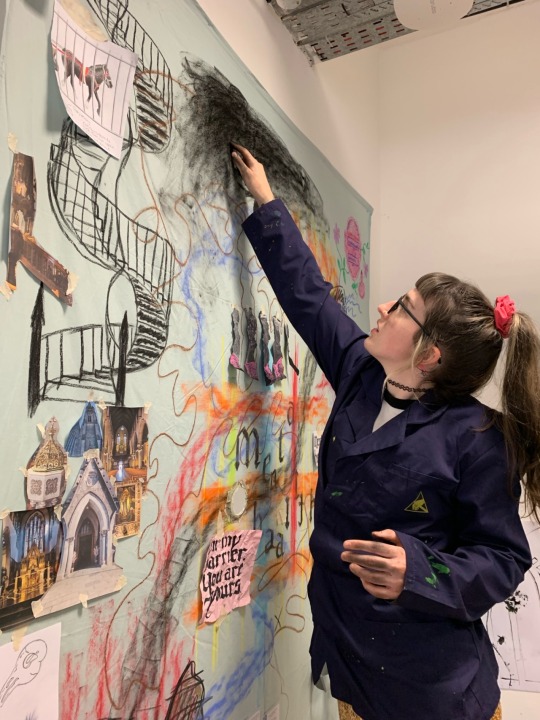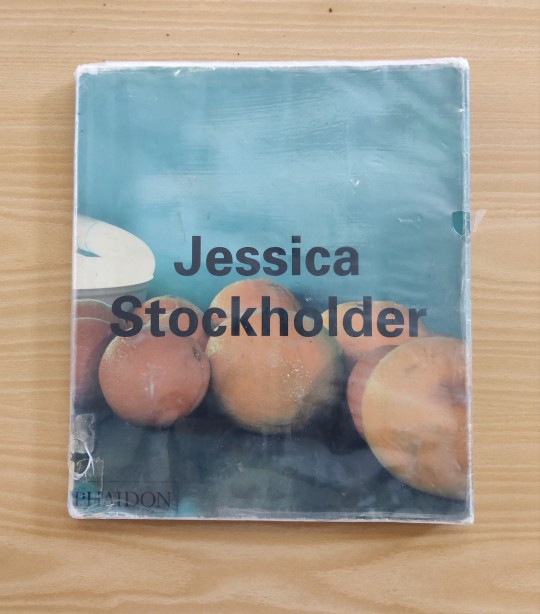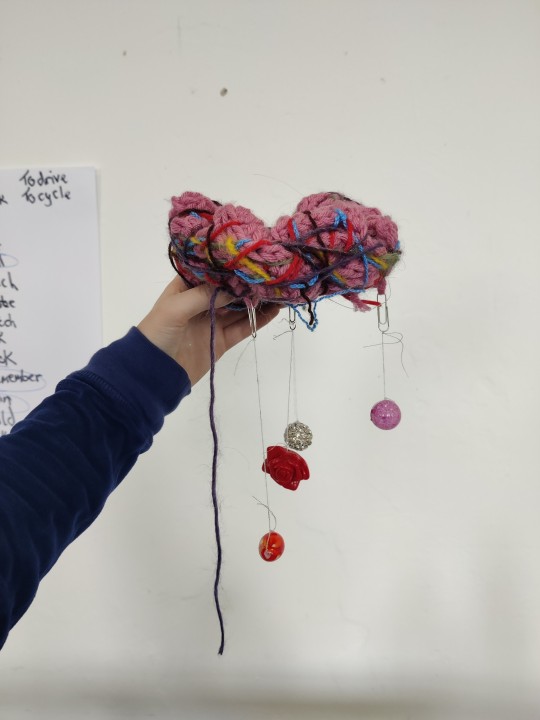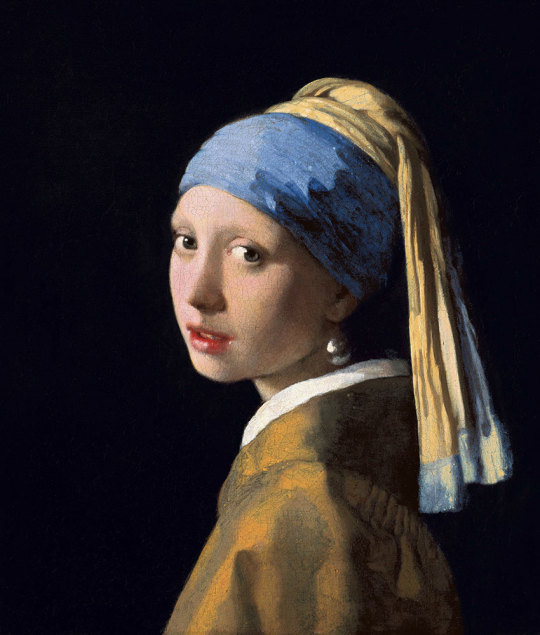#kelly grovier
Explore tagged Tumblr posts
Text


Tuesday 03/10/23
I began this day by finishing up my collage bed sheet. I added lots more colour to it, which represents different emotions (like the threads I added to the brain I am making)
The work on the sheet represents a viscous cycle of barriers and vulnerabilities, and to help to portray this more, I used heavy string to create a spiral circle that goes around and around.
Similar to my crocheted brain, I added a black hole at the top of the sheet. One of my college peers took a picture of me touching the hole. I thought this would look cool as when I was shading it before, my hands became covered in black. It represents to me,letting the darkness in and infect me.
The crutches and torn sheet are my portrayal of the choice to break the cycle, to move on from it. But there is a sense of unknown in this choice.
The suitcase with pillow and blanket popping out of it represents that the cycle is carried with me, that I revert back to it when I really need it.
The cardboard box represents the barrier of having no known meaning to life and the confusion of always feeling like I don't fit in.




The four photos above are from books I used to help inspire my work. These books were "100 works of art that will define our age" by Kelly Grovier and "Jessica Stockholder" by Barry schwabsky, Lynne Tillman and Lynne cooke.
Jessica stockholder's work and Grayson Perry's work helped to inspire my work, aswell as Tracy Emin's work (see post Week 2 Part 1 30/09/23)



I also finished my brain. I had brought in some jewels I had at home and I hung them off the brain. Each jewel portrays a certain thing I want to be better at and all together they represent my deep desire to be a better person, which weights me down. I also added gems to represent that I am constantly growing and not stagnant.
For the Black hole, I used some squares of a plastic bin bag. I like the idea of using this as it shows how my brain thinks I'm shitty. But if I had more time (the project ends Thursday) I would love to try some ideas I got from my lecturer Giordana Gaiche from fashion textiles, like dipping material into wax to give off a wet look to the Black hole.
I am really happy with how my project has progressed and I am excited to present it Thursday!
#art#barriers#lsad#radius#radiusproject#tus#mental health#bedsheet#disability#fahsion#brain#collage#colorful#messy#emotional baggage
17 notes
·
View notes
Text
28/10/2023
Disrupt
One of the artists that inspired me for my Disrupt project was Louis Bourgeois, in particular her spider sculpture 'Maman' (1999). It is made out of bronze,steel and marble and is 9 meters high. Louis Bourgeois explained that 'Maman' is an ode to her mother.
'Like a spider, my mother was a weaver. My family was in the business of tapestry restoration, and my mother was in charge of the workshop. Like spider, my mother was very clever. Spiders are friendly presences that eat mosquitoes. We know that mosquitoes spread diseases and are therefore unwanted. So, spiders are helpful and protective, just like my mother.'
Bourgeois's mother died in 1932 which was the year she enrolled at the École des Beux-Arts. In 8 November 2011 a year after Bourgeois's death at the age of 98, a smaller 2.4-metre-tall version of the 'Maman' was sold for 10.7 million dollars at auction in New York , which was the highest price paid for a work by a female artist to date.

These are the books from the library which I used fpr the research. Above photo shows page from '100 works of art that will define our age' and below are photos of 'Runaway Girl The Artist Louise Bourgeois'.



Sources:
'Runaway Girl The Artist Louise Bourgeois' by Jan Greenberg and Sandra Jordan
'100 works of art that will define our age' by Kelly Grovier
'Reputations Louise Bourgeois' by Maria Gil Ulldemolins
2 notes
·
View notes
Text
David Bowie hired him to create the cover art for his album Space Oddity. Most, however, simply plagiarised .... without paying him a cent or acknowledging their debt. - Kelly Grovier / BBC, 5th March 2019


David Bowie, Victor Vasarely
288 notes
·
View notes
Text
A list for the 2nd Friday of 2024
Welcome to 2024….12 days in!
I hope that thus far your year has gone well. I personally enjoy the resetting of a new year, when you can implement new focuses, improve older ones, and look forward to growth and fun. I’ve included a list of some bits and bobs I’ve been enjoying and found interesting as well as some photos.
Hopefully you find something to enjoy and have a great weekend.
The ‘$40 Pencil’ That Almost Went Extinct (wsj.com)
John Steinbeck used one to write “The Grapes of Wrath” and a Disney animator was buried with one. Blackwing pencils gained a coveted status among creatives for their speed and smoothness. Here’s why they almost went extinct and what it took to bring them back.
The lost ancient practise of communal sleep (bbc.com)
Until the mid-19th Century, it was completely normal to share a bed with friends, colleagues and even total strangers.
Masters of the Air — Opening Title Sequence | Apple TV+ - YouTube
Based on Donald L. Miller’s book of the same name, and scripted by John Orloff, “Masters of the Air” follows the men of the 100th Bomb Group )the “Bloody Hundredth”) as the conduct perilous bombing raids over Nazi Germany and grapple with the frigid conditions, lack of oxygen, and sheer terror of combat conducted at 25,000 feet in the ir. Portrating the psychological and emotional price paid by these young men as they helped destroy the horror of Hitler’s Third Reich, is at the heart of “Masters of the Air.” Some were shot down and captured; some were wounded or killed. And some were lucky enough to make it home. Regardless of individual fate, a toll was exacted on them all.
A Notebook to Save You from Infinite Scrolling & Boredom (youtube.com)
In this video, Parker gives an idea for a pocket notebook that can help free you from the infinite scroll and help you utilize your boredom for your own intellectual good.
Music’s power over your brain, explained | Michael Spitzer (youtube.com)
Music affects the brain in profound ways. It eases stress by lowering cortisol. It floods the brain with pleasurable neurotransmitters like dopamine. And it serves as a conduit through which we can process emotions that otherwise might not be describable in words.
If I Had a Heart - VIKINGS // Anna Miilmann, Johan Karlström & Danish National Symphony Orchestra (youtube.com)
Performed by Anna Miilmann, Johan Karlström & Danish National Symphony Orchestra & Vocal Ensemble Conducted by Henrik Vagn Christensen
How a 1574 portrait was made 'Insta-fabulous' (bbc.com)
Restorers are uncovering "forgotten faces" that were later retouched, with painters adding plump lips, sculpted noses and tapered chins centuries afterwards, writes Kelly Grovier.
The Habits for Happiness Quiz | Gretchen Rubin
A fun quiz to help you choose what the next habit that could make you happier might be.
#newyears#newyear#2024#welcome#photography#fun#music#learntogrow#themoreyouknow#history#pencils#streaming#tv
0 notes
Text
<b>Trump's</b> mugshot to Burning Man: Six of the most striking images of 2023 - BBC Culture
New Post has been published on https://www.google.com/url?rct=j&sa=t&url=https://www.bbc.com/culture/article/20230925-trumps-mugshot-to-burning-man-six-of-the-most-striking-images-of-2023&ct=ga&cd=CAIyGjUzM2UwMTY5ZmFhZTIwMGQ6Y29tOmVuOlVT&usg=AOvVaw3ZiBJ7U1riCi8hXR9L6YEX
Trump's mugshot to Burning Man: Six of the most striking images of 2023 - BBC Culture
Kelly Grovier picks six of the most powerful photos from this year – including Trump’s mugshot and a traffic jam in the desert at Burning Man …
0 notes
Text
In a new podcast episode from Yale University Press, author Kelly Grovier talks about his new book, The Art of Colour: The History of Art in 39 Pigments. “Pigments are the syllables art speaks in,” Grovier writes in the book. “To understand what they are saying, it may be helpful to trace their discovery and track the gradual accrual of connotations over time. Where etymology involves establishing a word’s genesis and evolution, perhaps we might call the approach pursued here, of mapping the emergence of a given pigment in order to appreciate more profoundly its significance in a given work, something analogous: artymology.”
0 notes
Photo

“A moça que usa um brinco de pérola reluzente no famoso quadro de Vermeer se volta perpetuamente em nossa direção ou para longe de nós? Pense bem.
O adereço em torno do qual gira o mistério da pintura é apenas um pigmento da sua imaginação. Com um movimento de pulso e duas pinceladas habilidosas de tinta branca, o artista enganou o córtex visual primário do lobo occipital de nossos cérebros.
Aperte os olhos com a força que quiser, não há nenhum gancho ligando o ornamento à orelha. Sua própria esfericidade é uma farsa.
Desejamos que o brinco estivesse suspenso na aus��ncia de gravidade a partir dos mais insignificantes apóstrofos brancos. A joia preciosa de Vermeer é uma ilusão de óptica opulenta, que se reflete em nossa própria presença ilusória no mundo.”
- Kelly Grovier, para o caderno BBC Culture.
#blog#salvador dalí me entenderia#bbc#bbc culture#kelly grovier#moça com brinco de pérola#vermeer#johannes vermeer
2 notes
·
View notes
Photo




https://www.bbc.com/culture/article/20200910-the-school-of-athens-a-detail-hidden-in-a-masterpiece
#Gianluca Mercuri#Corriere della Sera#Kelly Grovier#BBC#Raffaello Sanzio#La scuola di Atene#storia dell'arte
1 note
·
View note
Photo

Thank you Kelly Grovier and BBC for a fantastic article on the abstract expressionist female painter Michael (Corinne) West. - Blinding Light: The ‘Great American Painting’? https://www.bbc.com/culture/article/20201002-blinding-light-the-great-american-painting
1 note
·
View note
Link
The first flush of works is characterised by a primitivist poetry of dreamlike forms floating in enchanted landscapes with a levitational allure that recalls the mystical visions of Marc Chagall, whose own fierce folkloric imagination had been forged by the violence of pogroms. But it isn't long before figurative storytelling gives way to a more ambiguously amorphous cadence of expression that strayed beyond Surrealist impulses to pure abstraction. With no inculcated allegiance to any artistic school or prejudice regarding the appropriateness of materials, Sobel began playing both with what a painting can say and how it can say it. Using unconventional implements such as glass eye-droppers to squirt paint and the strong suck of a vacuum to drag wet splatters into thin gossamers that no traditional brush could spin, she assaulted the surface of canvases laid out on the floor, orchestrating a liquid lyricism of spills, splashes and spits the likes of which had never before been seen.
The result was works such as Milky Way, 1945 – a silent symphony of delicate enamel whorls and surging spatters that Sobel created two years before Pollock would fling his first skirl of paint or began producing his own inchoate cosmic sonatas such as Galaxy (1947). Some creative coincidences can be chalked up to the untraceable synergies of zeitgeist – contemporaneous imaginations incidentally synchronised to the same cultural stimuli. This isn't one of them. Pollock was profoundly influenced by Sobel's work, and history has saved the receipts. Almost as quickly as Sobel had begun to experiment with making images, her son Sol set about attracting attention to her remarkable efforts, reaching out to everyone from Chagall himself to the influential art collector Sidney Janis, who would prove instrumental in establishing the reputations of everyone from Willem de Kooning to Mark Rothko to Pollock.
By 1944, Sobel was well on her way to being a formidable fixture in the New York art scene, debuting that year with a solo show at the Puma Gallery on 57th Street – an exhibition that yielded widespread praise for her works' "astounding sophistication" and "absolutely unrestricted" imagination. Janis (who predicted that Sobel "will probably eventually be known as one of the important surrealist artists in this country"), included her work in a prominent exhibition Abstract and Surrealist Painting in America that toured the country that year.
...
Whatever one's estimation of the relative merits of Sobel's and Pollock's work at this moment in the unfolding narrative of modern art, as history would have it, Pollock would prove to be in the far stronger position to advance the technique of drip painting, whether it was his invention or not. Just as Sobel was gaining traction as a creative force in New York – no small feat for a female artist of her or any generation – her circumstances suddenly changed dramatically, and in ways that effectively removed her from the world of art completely. In 1946, the same year that she opened a solo show at Guggenheim's Art of the Century gallery, her husband Max, moved the family from Brooklyn to Plainfield, New Jersey, in order to be nearer to his costume jewellery enterprise. Unable to drive, Sobel quickly found herself cut off from the ebb and flow of the art scene in which she had only just become an important player.
Compounding that geographic disadvantage was the decision taken the following year by her biggest advocate, Peggy Guggenheim, to relocate to Europe, closing behind her the doors of the Art of the Century gallery – Sobel's principal platform. Adding insult to injury, the onset of an allergy to an ingredient in paint forced Sobel to turn instead to media such as crayons that were less conducive to the drip technique, all but forcing her to abandon the innovation entirely. By 1948, Janet Sobel, who would die in obscurity 20 years later, had effectively vanished from the art world. Though not without a trace. Her enduring genius can still be mapped in the innumerable knots and infinite coils of pigment with which Pollock will proceed to intertwine his more famous canvases – endlessly weaving her spirit into the tangled firmament of art history.
71 notes
·
View notes
Text



Radius project Week 2 progress 25/09/23 - 29/09/23 (part 1)
On monday, at the near end of the day, I went up to the cathedral (with a member of my peer group) to take some more images of it, to continue to explore my barrier idea.
But when we got up there, GO TOBANN, the previously locked and closed doors were opened! So we went inside and explored the interior of the cathedral.
I was very interested in the feeling I got inside of fragility and caution. I felt as if I should not be here, due to the delicately beautiful objects (Madonna and Child image) that I had a fear of damaging and the quietness inside.
I am now intrigued to explore the vulnerability behind a barrier, aswell as barriers.

As seen from above, I have started to play with an idea of the sheet being a messy bed. For me, a bed is a form of utter protection and comfort, so much so that it can become a barrier. The mess covered on it would then represent trauma human beings carry.

"My bed" by Tracey Emin is similar to what I want to portray in my project and it inspires me to keep creating it too. Referenced from the book: "100 works of art that will define our age" by Kelly Grovier.

This image shows a rough drawing I did, of a depressed person in bed. I scrunched up the sheet to show the damage the person feels and the tore it into strips to portray the railings I saw at the cathedral. Its deep meaning is that overprotection is a barrier which leads one to become disconnected from oneself.
I hope to create this better, through either a painting or an animation.

The last image here is the work I have done so far (missing is the railing drawing I talked about previously). I have moved around print outs and drawings, and I brought in 3d items from home to act as barriers. These 3d items now though, carry a sense of vulnerability to them too.
I am really enjoying exploring this, and I hope that I have enough time to do more.
I will explain more in part 2!
#art#barriers#cathedral#lsad#radius#radiusproject#tus#toxic masculinity#vulnerability#mental health#trauma#bedsheet#bed#comfort#overprotection#3d#2d
10 notes
·
View notes
Photo










Sean Scully Land Sea
a cura di Danilo Eccher
saggi di Danilo Eccher, Kelly Grovier, Ben Luke e intervista di Hans Ulrich Obrist
Skira, Milano 2015, 168 pagine, 200 ill.colori, 24.5 x 28.5cm, ISBN 9788857227641
euro 39,00
email if you want to buy [email protected]
Mostra a Venezia, Palazzo Falier 9 maggio – 22 novembre 2015
L’opera dell’artista statunitense di origini irlandesi Sean Scully, rappresentante di spicco dell’arte astratta contemporanea.Pubblicata a corredo della mostra inserita nell'ambito degli eventi collaterali della 56. Esposizione Internazionale d’Arte la Biennale di Venezia, la monografia presenta una vasta selezione di lavori monumentali realizzati per l’occasione, che rappresentano la ricerca che Scully ha intrapreso negli ultimi anni, contribuendo in maniera significativa al dibattito sull’importanza dell’arte astratta nella contemporaneità. Vengono presentate la serie Doric (2010-2013), opere ad olio su alluminio dove lo studio degli aspetti architettonici e l’approfondimento del ruolo della pittura geometrica si confrontano con le possibilità molteplici della sperimentazione cromatica. A queste opere si aggiunge una selezione di dipinti della serie Landline (2014) con larghe fasce orizzontali di blu e grigi che paiono librarsi una sull’altra; esplorazioni del concetto di paesaggio e di storia in una continua ibridazione di astrazione ed esperienza. Quelle di Scully, scrive Danilo Eccher, sono “opere che suggeriscono una dimensione poetica ma non sfuggono all’esperienza della luce, alla sua rifrangenza, alla sua dilatazione cromatica, affondando nella tradizione del colorismo veneziano e insistendo nel rigore di un concettualismo attuale”. Il progetto veneziano ha portato l’artista a relazionarsi con i suoi ricordi legati alla città lagunare, ai colori e ai movimenti dell’acqua, ai mattoni ma anche con le suggestioni del luminismo di Tintoretto, con il tonalismo di Bellini e la materialità cromatica di Tiziano.
La monografia comprende i saggi di Danilo Eccher (Sean Scully: Land Sea), Kelly Grovier (Tredici modi di guardare una Landline), Ben Luke (Un’austerità sensuale. Materialità e luce nella pittura di Sean Scully) e un'intervista di Hans-Ulrich Obrist all'artista.
01/04/22
orders to: [email protected]
ordini a: [email protected]
twitter: @fashionbooksmi
instagram: fashionbooksmilano, designbooksmilano tumblr: fashionbooksmilano, designbooksmilano
#Sean Scully#art exhibition catalogue#Palazzo Falier Venezia 2015#arte astratta#serie Doric#serie Landline#fashionbooksmilano
14 notes
·
View notes
Link
Purple is a paradox, a contradiction of a colour. Associated since antiquity with regality, luxuriance, and the loftiness of intellectual and spiritual ideals, purple was, for many millennia, chiefly distilled from a dehydrated mucous gland of molluscs that lies just behind the rectum: the bottom of the bottom-feeders. That insalubrious process, undertaken since at least the 16th Century BC (and perhaps first in Phoenicia, a name that means, literally, ‘purple land’), was notoriously malodorous and required an impervious sniffer and a strong stomach. Though purple may have symbolised a higher order, it reeked of a lower ordure.
[...]
In ancient Greece, the right to clad oneself in purgative purple was tightly controlled by legislation. The higher your social and political rank, the more extracted rectal mucus you could swaddle yourself in. According to the Roman historian Suetonius, King Ptolemy of Mauretania’s sartorial decision to cloak himself in purple on a visit to the Emperor Caligula, cost Ptolemy his life. Caligula interpreted the fashion statement as an act of imperial aggression and had his guest killed. Purple, it seems, was also to die for.
4 notes
·
View notes
Photo

Janet Sobel: The woman written out of history
In 1938, a Ukrainian-born grandmother created one of art's biggest shocks – but it was attributed to the US painter Jackson Pollock. For International Women's Day, Kelly Grovier explores the influence of Janet Sobel.
2 notes
·
View notes
Text
O misterioso 'brinco de pérola' da moça da obra de Johannes Vermeer
O misterioso ‘brinco de pérola’ da moça da obra de Johannes Vermeer
A Moça Com Brinco de Pérola (Meisje met de parel) usa um brinco de pérola? Apesar de parecer redundante, a obra clássica de Johannes Vermeer, de 1665, esconde um segredo. É uma das deliciosas revelações do livro A New Way of Seeing: The History of Art in 57 Works (“Uma Nova Maneira de Ver: A História da Arte em 57 Obras”, em tradução livre), da escritora Kelly Grovier. O adereço é apenas um…

View On WordPress
#ahistoriadaarteem57obras#ARTE#cultura#featured#johannesvermeer#kellygrovier#mocadobrincodeperola#news
2 notes
·
View notes